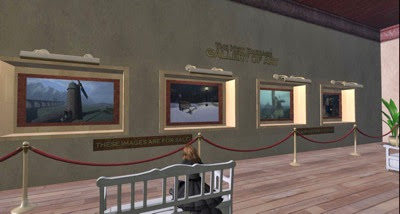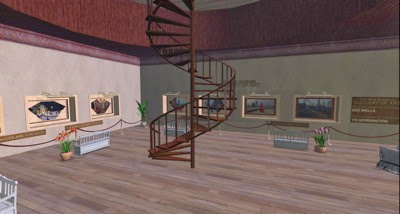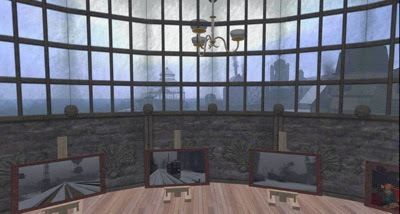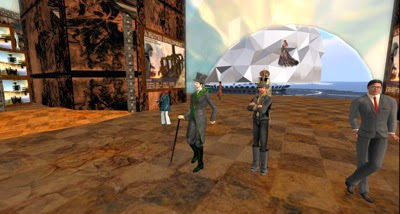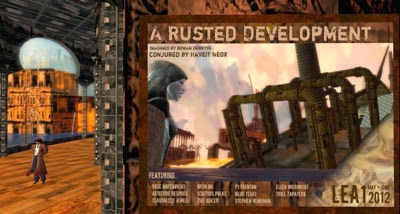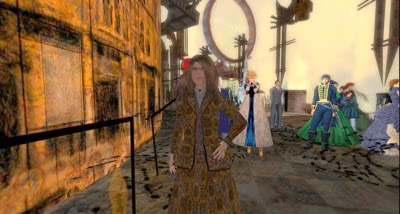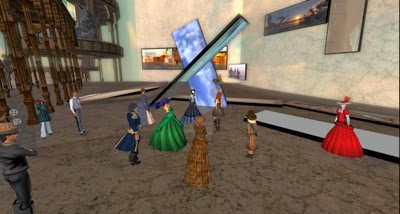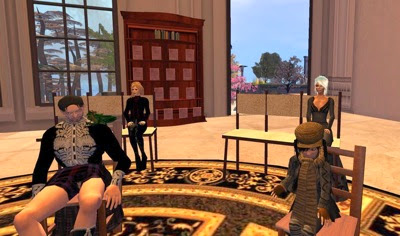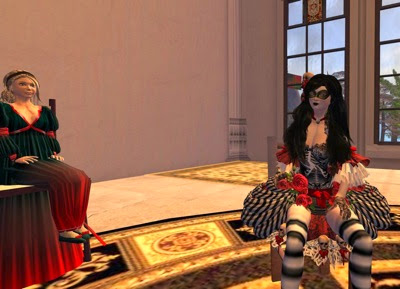I feel a little awkward writing these mini-reviews or random thoughts, or whatever they may be, on Doctor Who, as I'm not really qualified to discuss the show. Unlike the serious fans - the fanatical fans, to be redundant - who have studied the earlier incarnation of the series and/or pored over every frame of the new version of the series, I'm a newcomer, still working my way to the Matt Smith era. Nonetheless, I've been spending a good chunk of my free time at this, so I may as well report back.
Episode 0: The Christmas Invasion
The Doctor, having regenerated at the end of the previous season, spends much of this episode in bed, recuperating from the effects of the regeneration. An alien race, the Sycorax, trigger a device that causes a third of the Earth's population to fall into a hypnotic state and walk to a precipice; the Sycorax leader demands that the Earth surrender or he will order the hostages to plunge to their deaths. Rose Tyler, Rose's annoying mother, and Mickey Smith soldier on without the Doctor, as does Prime Minister Harriet Jones. The Doctor wakes up (with a good restorative tea), fights the Sycorax leader, loses a hand but is able to use regeneration energy to grow another - and the hand sticks around for the next three seasons until it is needed by the plot - and ultimately defeats the Sycorax leader. He banishes the rest of the Sycorax. However, PM Jones ordered Torchwood to destroy the alien ship against the Doctor's orders.
One would think these Christmas specials would have more time and attention lavished on them, including the plot, but in reality the opposite seems true. This one wasn't bad, but, lacking the Doctor for much of the episode, the piece seemed slightly underwhelming.
Episode 1: New Earth
The Doctor and Rose travel to the planet New Earth in the year five billion and twenty-three. In a hospital they find cat-like nurses curing incurable diseases, and the Doctor's old friend, the Face of Boe. Rose gets kidnapped and is taken to the Lady Cassandra, who survived from the previous season's episode involving the death of the original Earth in the year five billion. Cassandra has a device that swaps her mind with Rose's. The Doctor has to get Cassandra to give Rose back and to understand the miracle cures.
The second of the two main plot points isn't bad, even if the resolution is a little sketchy on the science, but one episode with Lady Cassandra was more than enough.
Episode 2: Tooth and Claw
The Doctor misses landing in 1979 by a century, so he and Rose find themselves in rural Victorian Scotland. Queen Victoria herself is passing through the area, to spend the night at the Torchwood Estate. Inside the estate, a group of rogue monks have taken over, and a werewolf is on the prowl.
This is one of the best episodes of the series: tense, and the plot elements are all well-integrated. We also get the back story of the Torchwood Institute, which infuses the rest of the season.
Episode 3: School Reunion
An amusing but slight plot, with bat-like creatures taking over the school in order to solve an algorithm that would give them control of time and space. The episode sees the return of popular companion Sarah Jane Smith, and she and Rose get into a bragging match. Rose gets some insight into what being the Doctor's companion really does to a person. (The idea that Rose was unaware that the Doctor had previous companions seems farfetched, however.)
Episode 4: The Girl in the Fireplace
Another excellent episode. The Doctor, Mickey, and Rose find an abandoned spaceship in the 51st century. They look through a fireplace and see a young girl in 18th century clothing. The fireplace is a portal between the ship and the bedroom, though time passes more quickly on the 18th century side. The girl grows up to be Louis XV's mistress, Madame de Pompadour. She sees the Doctor as someone who shows up briefly then disappears for years. The episode is one of the few sexy ones, too. The explanation for why the automatons were harassing Madame de Pompadour was unconvincing, however.
Episodes 5 and 6: Rise of the Cybermen/The Age of Steel
A two-part story line, in which the Doctor and Rose travel to a parallel Earth - one in which Rose's father is not only still alive but has made a fortune in one of his crazy get-rich-quick schemes. Everyone has a pair of EarPods (heh), which downloads news and information directly into the brain. The developer of the EarPods, John Lumic, has a plan to convert humans into cybernetic beings - with himself as their immortal leader, and has experimented with the homeless. Mickey Smith meets his alternate universe counterpart, who is a member of a counter-revolutionary group.
I liked this story. Mickey finally gets to feel useful (despite the help he's given the Doctor in previous episodes, he's always felt like a fifth wheel). Rose gets to see her parents together, only to find that in this alternate reality they have no children. Still, she's tempted to stay with this version of the father she never knew.
Episode 7: The Idiot's Lantern
The Doctor and Rose arrive in London on the day before Queen Elizabeth II's coronation. The entire neighborhood is buying television sets in order to watch the event. However, people who watch the television sometimes end up faceless, a victim of the Wire, an entity stuck in the television wavelength who sucks energy out of those watching. The Wire plans on using the coronation as an opportunity to get enough energy to return to a physical form.
The commentary on television is amusing, and the Doctor shows his manic side, but the episode is not one of the stronger ones. I did like the MacGyver-like building of a VCR, in 1953, from spare parts - Betamax, for better or worse.
Episodes 8 and 9: The Impossible Planet/The Satan Pit
Also a two-part story line, taking place mainly in a dark, sweaty station on a planet at the edge of a black hole - the planet shouldn't be able to continue to exist, hence the episode title. The Doctor sees some untranslatable symbols - something that shouldn't happen, as the TARDIS can translate all languages. They investigate further, discovering the Ood, a servant race, along with the human crew members. As the crew drills into the planet, one of the crew exhibits signs of being possessed by an evil force. An earthquake causes the TARDIS to fall into the deep drilling pit, so the Doctor and Rose are forced to stay on the planet. The first episode-and-a-half was good, while meeting Satan was somewhat underwhelming.
Episode 10: Love and Monsters
An episode told mainly from the perspective of a young man (and ELO fan!) who is obsessed with the Doctor, who connects with similar-minded people. The group - originally intended to investigate Doctor-related phenomena - turns into a social club until it is visited by a man who points out that the group has lost its original cause. Out of an initially undisclosed ulterior motive, he redirects the group toward finding the Doctor. One by one, however, members of the group start disappearing.
Ugh. I know this was supposed to be funny, but it just wasn't. The Doctor-obsessed fans weren't all that interesting, the people-eating alien was comical but not terribly interesting, and, most of all, the Doctor was again missing in action for most of the episode.
Episode 11: Fear Her
Intending to see the London 2012 Olympics, the Doctor and Rose land in a housing estate near where the Olympic torch is to pass by shortly. Several children have disappeared, and when the Doctor investigates the culprit appears to be a 12-year-old girl, who draws pictures of people and animals who are then trapped in her drawings.
Good, but not great. The highlight was seeing the Doctor running with the Olympic torch, though having him bring it into the stadium was over the top.
Episodes 12 and 13: Army of Ghosts/Doomsday
Rose opens the episode with a narration, saying, "This is the story of how I died." The episode then begins in the present (2006) London estate where Jackie Tyler lives. The Doctor and Rose find that "ghosts" have been appearing worldwide, but for part of the day only. Rather than dead relatives coming back to visit the living, as Jackie and others believe, the Doctor realizes these are beings attempting to cross into our universe. He traces the origin to Canary Wharf, to what turns out to be the Torchwood Institute. An impenetrable object came through the breach. Scientists are trying to use the breach in the universe, through which the ghosts came, to develop an inexhaustible energy source. They open the breach once more, allowing the Cyberman army to come through. The object opens, revealing Daleks.
Despite the excess (pairing the Cybermen and the Daleks?) and the hand-waving plotting, the double episode was very good. And who could resist the poignant ending, separating Rose from the Doctor, seemingly forever?
Tennant versus Eccleston
I realize it's a cliche to get into the "which Doctor is better" discussion, really I do. After seeing Series 1, with Christopher Eccleston,
I opined that Eccleston was excellent in the role, playing the Doctor with a combination of humor and anger. I still think it's too bad he didn't stay in the series for a few more seasons. David Tennant is a very different sort of actor. Much of the time he's goofier - a carefree sort, or, as I came to believe, a world-weary man with a carefree facade. (Sometimes the mask slips. In a Series 4 episode, "The Waters of Mars," the Doctor is told "Nobody should have that power" over time and over the fate of people. His response: "Tough.")* And just as Eccleston had his catch phrase - "Fahn-TAS-tic!" - so does Tennant: "I'll get you out of this, I promise." (His related catch phrase: "I'm sorry. I'm so sorry." And he does seem sorry; unfortunately for him, he's sorry a lot.) Both good in their own way.
* Yes, my viewing is far ahead of my writing.

